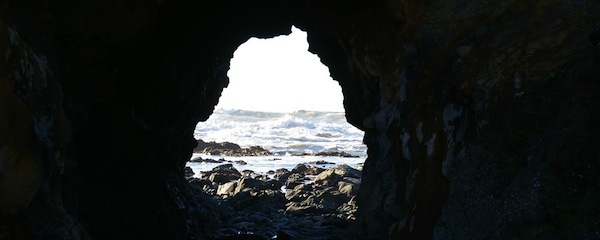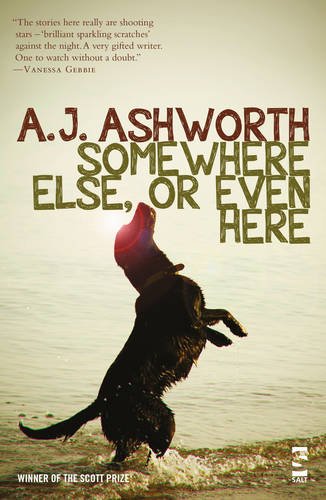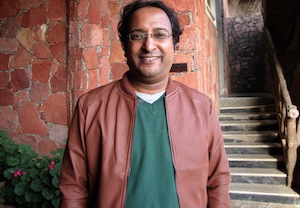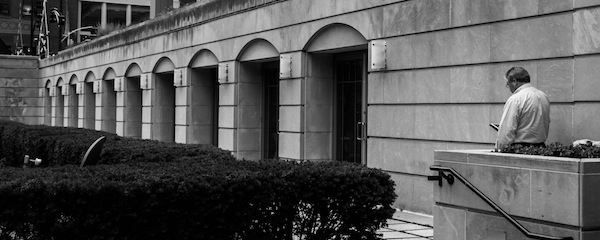
photo © John Vonderlin, 2008
by Jose Varghese
Some short story collections open with a very strong story that takes you by surprise, to the point of wondering whether the writer will, as we read the stories that follow, live up to the expectations thus raised.
‘Sometimes Gulls Kill Other Gulls’, from A.J. Ashworth’s collection of stories Somewhere Else, Or Even Here, was one that had such an effect on me. It made me doubt whether it was humanly possible to be so consistently brilliant across all fourteen stories in the collection. My doubts were proven wrong. It was not just that the other stories were as good, but there were some that even surpassed the structural and thematic originality of the first, like ‘The Future Husband’, ‘Paper Lanterns’, ‘Bone Fire’, ‘Tattoo’, ‘Offerings’ and ‘Overnight Miracles’, to mention just the ones that bowled me over.
‘Sometimes Gulls Kill Other Gulls’ remains my favorite, though; I will remember the author and the book for this opening story, in the years to come. The title drew me in instantly, and the sparse, understated narrative that later progressed to a chilling narration of a totally unexpected turn of events on a beach in an evening kept me on tenterhooks. In an interview with the writer and academic Adnan Mahmutovic on Ashworth’s blog, Ashworth reflected on her approach to short fiction:
I start small and stay small. I don’t really think about the larger life and take a chunk of that; I just automatically see the fragment and explore that. For me, it’s like the idea of the microcosm and the macrocosm. The microcosm or little world will always contain enough detail to hint at that bigger world. A grain of sand contains aspects of the shell or rock from which it came, as well as the beach and ocean (to paraphrase Steven Millhauser).
 This explains how her story works. Though it is narrated from a third person perspective, the story explores the point of view of the young girl Lainey, for the most part.
This explains how her story works. Though it is narrated from a third person perspective, the story explores the point of view of the young girl Lainey, for the most part.
Lainey is shown self-indulgently drawing her name on a sandy beach with a stick, being aware of her dad ‘asleep on a towel the colour of dull grass’ and her mother reading ‘the magazine that’s collapsed in her lap like a huge, tired butterfly’. As an intrusion to this state of bliss comes a local boy a couple of years older than Lainey. Just like any other girl would, Lainey resists this intrusion of her space by the boy, who introduces himself as Jeremy. But she also experiences a pull towards the strange, unknown world Jermey represents and tries to describe.
When Jeremy mentions that gulls kill each other at times, she tries to counter that. When he describes such an incident in which a gull dies with its eye hanging out, she thinks it’s disgusting. When he reveals that it was he who put it out of its misery by stamping on its head, she observes that he was wrong then about gulls killing other gulls.
Jeremy entices her away with a description of rock pools and a cave.
“This is boring,” he says. “Do you want to go over to those rocks instead?” He nods at a far corner of the beach where the sea sweeps around in a crescent. “There’s rock pools and a cave. I can show you.”
Lainey turns to her parents; they are two fish pulled from the water and laid to dry. “I have to stay here,” she says, shrugging one shoulder.
“They your parents?” he asks.
Lainey nods.
“They’re asleep,” he says.“They won’t even know you’ve been anywhere.”
Despite her initial doubts and reluctance, she follows him in an adventurous spirit, without taking permission from her parents. Once in the cave, she feels at ease for a while, as long as they enjoy the innocent exploration of the hidden world. Then they come across an old Labrador trapped in a pool. The dog is unable to come out of the cold water, and is about to die. Lainey’s earnest efforts to save it are mocked by Jeremy, though he seems to know how to deal with the dog better than her. She takes charge, asks him to hold the dog’s head up as she goes in search of her stick, which she left near the rocks. Once she is out of the cave, she realises the passing of time, and there are dark clouds. When she comes back with the stick, the dog is dead, and she suspects that Jeremy killed it.
Lainey argues with Jeremy and threatens to go out and tell what he did, to the man they have seen on their way to the cave, assuming he was the owner of the dog. It is then that Jeremy shows a different face:
“I’m going to tell that man,” she says, her voice strong again. “And I’m going to tell him what you’ve done.” She marches towards the opening.
He sticks his leg out so she can’t get past. “You’re not.”
She pushes at his leg, but he steps in front of her, still looking at the ground.
“I’m,” she says.
He speaks again, so low this time that at first she doesn’t understand what he’s said. Then her brain makes sense of it. “What if I push you in the water with that dog?”
Lainey sees the shadows on the rocky walls of the cave and how they lurch and stagger from side to side. Her heart taps inside her like fingers on a window. “What?” she says, noticing how Jeremy seems bigger now, so that she can hardly see the way out at all.
“I could,” he says, “push you in.”
Just as Lainey considers using her stick in self-defense, she is relieved to hear noises outside and her dad comes in to save her from the situation. Something changes between the kids that moment before which each was up to harm the other and, it seemed, danger, or even death, was just a second away.
… Jeremy’s shoulders drop and he stands aside to let her pass, presses his back into the cave wall.
“I wasn’t going to do anything,” he says, in the same quiet way. “I wouldn’t have touched you.”
Once she escapes from the situation, Lainey is eager to go home, leaving behind her stick, her name written on the beach, the dead dog, the man calling out for it, and Jeremy.
 The title of the story has a menacing effect during the climax. The mystery about Jeremy, as seen through the eyes of Lainey, contributes a lot to the tension. It is not clear whether Jeremy is really harmful, or just a small kid trying desperately to impress a younger girl in his own ways. His big talk has an effect too, though Lainey is always on the defense. There is a moment when a reader might wonder whether Lainey would overreact and put Jeremy’s life in danger – the only moment when the story escapes a bit from Lainey’s view of the situation.
The title of the story has a menacing effect during the climax. The mystery about Jeremy, as seen through the eyes of Lainey, contributes a lot to the tension. It is not clear whether Jeremy is really harmful, or just a small kid trying desperately to impress a younger girl in his own ways. His big talk has an effect too, though Lainey is always on the defense. There is a moment when a reader might wonder whether Lainey would overreact and put Jeremy’s life in danger – the only moment when the story escapes a bit from Lainey’s view of the situation.
Despite the notion of danger that lurks in the background, Ashworth narrates the charming ways in which children connect, though fleetingly, beyond their disparate life circumstances. It can be considered a coming-of-age story as well, despite its length of just above twelve pages. Just as Ashworth reflects, a small fragment of life is her concern here, but there is a lot about the larger aspects of life in that fragment. However, there is no attempt to present it as a cautionary tale, or to limit it wholly to the perspective of the privileged class. She keeps the story open-ended. Jeremy is an intriguing character, and though his motives remain vague, he is capable of taking charge and keeping at least a few situations under control. His acts can have multi-layered interpretations, just as the acts of Lainey. While it is not an easy task to tell an entire story from the perspective of a child and to hint at social and class differences, Ashworth succeeds wholly by juxtaposing conflicting dialogues, images and ways of thinking entirely from the world of children.
~
 Jose Varghese is a writer/editor from India who teaches English at Jazan University, KSA. He is the founder and chief editor of Lakeview International Journal of Literature and Arts. His poems and short stories have appeared in the journals/anthologies: The Salt Anthology of New Writing 2013 (UK), Unthology (UK), The River Muse (USA), Chandrabhaga (India), Kavya Bharati (India), Postcolonial Text (Canada) and Dusun (Malaysia). He was the winner of The River Muse 2013 Spring Poetry Contest, USA, a runner up in the Salt Flash Fiction Prize 2013, UK, a second prize winner in the Wordweavers Flash Fiction Prize 2012 and his poem was commended in Gregory O’Donoghue International Poetry Prize 2014. His first book was Silver Painted Gandhi and Other Poems, and his collection of short stories, Silent Woman and Other Stories, is slated for publication in 2015. He has done research on Post-Colonial Fiction and is currently working on Hanif Kureishi’s novels. He was a participating writer at Hyderabad Literary Festival 2012 and at the 2014 Vienna International Conference on the Short Story in English.
Jose Varghese is a writer/editor from India who teaches English at Jazan University, KSA. He is the founder and chief editor of Lakeview International Journal of Literature and Arts. His poems and short stories have appeared in the journals/anthologies: The Salt Anthology of New Writing 2013 (UK), Unthology (UK), The River Muse (USA), Chandrabhaga (India), Kavya Bharati (India), Postcolonial Text (Canada) and Dusun (Malaysia). He was the winner of The River Muse 2013 Spring Poetry Contest, USA, a runner up in the Salt Flash Fiction Prize 2013, UK, a second prize winner in the Wordweavers Flash Fiction Prize 2012 and his poem was commended in Gregory O’Donoghue International Poetry Prize 2014. His first book was Silver Painted Gandhi and Other Poems, and his collection of short stories, Silent Woman and Other Stories, is slated for publication in 2015. He has done research on Post-Colonial Fiction and is currently working on Hanif Kureishi’s novels. He was a participating writer at Hyderabad Literary Festival 2012 and at the 2014 Vienna International Conference on the Short Story in English.

